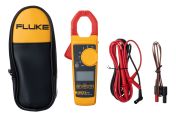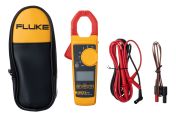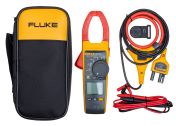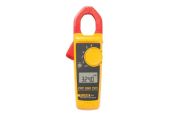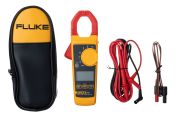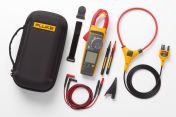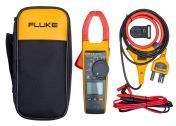Fluke Clamp Meters
A clamp meter is an electrical test tool that combines a basic digital multi meter with a current sensor. Clamps measure current such as AC current, AC and DC voltage, resistance, continuity, and, with some models, DC current, capacitance, temperature, frequency, and more. Clamp meters are designed with a hinged jaw, this allows the user to clamp the jaws around a wire, cable, or other conductors at any point in an electrical system, then measure the current without disconnecting it. They are extremely popular due to safety reasons, they are convenient to use, they identify issues when installations occur and are cost effective for ongoing tester, maintenance and service requirements.
Why would you need a clamp meter?
Originally created as a single-purpose test tool, modern day meters offer more measurement functions, greater accuracy, and sometimes specialised measurement features, as well as the most basic functions of a digital multi meter, such as the ability to measure voltage, continuity, and resistance.
Popular Clamp Meters
- AC Current
- DC Current
- AC-DC
- Leakage
- HVAC
- Power
Why are clamp meters so popular?
- Safety: Clamp meters allow electricians to bypass the old-school method of cutting into a wire and inserting a meter's test leads into the circuit to take an inline current measurement. The jaws of a clamp meter do not need to touch a conductor during a measurement.
- Convenience: During measurement, it is not necessary to shut off the circuit carrying current—a large boost inefficiency.
- Service: Repair existing systems on an as-needed basis.
- Installation: Troubleshooting installation problems, perform final circuit tests and supervise apprentice electricians while installing electrical equipment.
- Maintenance: Perform scheduled and preventative maintenance and system troubleshooting.
What are the advantages of Fluke Clamp Meters?
Fluke clamp meters provide a range of benefits for electrical testing. They are highly accurate and offer an array of features that make them more reliable than other types of multimeters. The readings from a clamp meter are not affected by varying temperatures or high-frequency signals, allowing users to get an accurate reading even in different environments. Additionally, they allow users to measure current without having to break into circuits and thus reduce risk during testing by eliminating the need for protective gear.
Other advantages include convenience as most models feature auto power off when idle and low battery indicator as well as backlit, digital displays which make it easier to read results under any lighting condition. Furthermore, Fluke clamp meters come with safety ratings up to CAT IV 600V/CATIII 1000 V making them suitable for use in industrial settings.
Popular Searches
Related links
- Current Clamps
- What is a Clamp Meter & How Do You Use One?
- RS PRO ICMA1 Clamp Meter Max Current 300A ac CAT III 600 V
- Fluke 376 Clamp Meter Max Current 1000A ac CAT III 1000V
- Facom 720.P1500PB Clamp Meter DC Voltage Max Current 1500A ac CAT IV
- BK Precision BK316 Clamp Meter Max Current 100A ac CAT II 600V
- Fluke 325 Clamp Meter Max Current 400A ac CAT III 600V
- Fluke Fluke 325 Clamp Meter DC Voltage Max Current 400A ac CAT III 600 V, CAT IV 300 V

